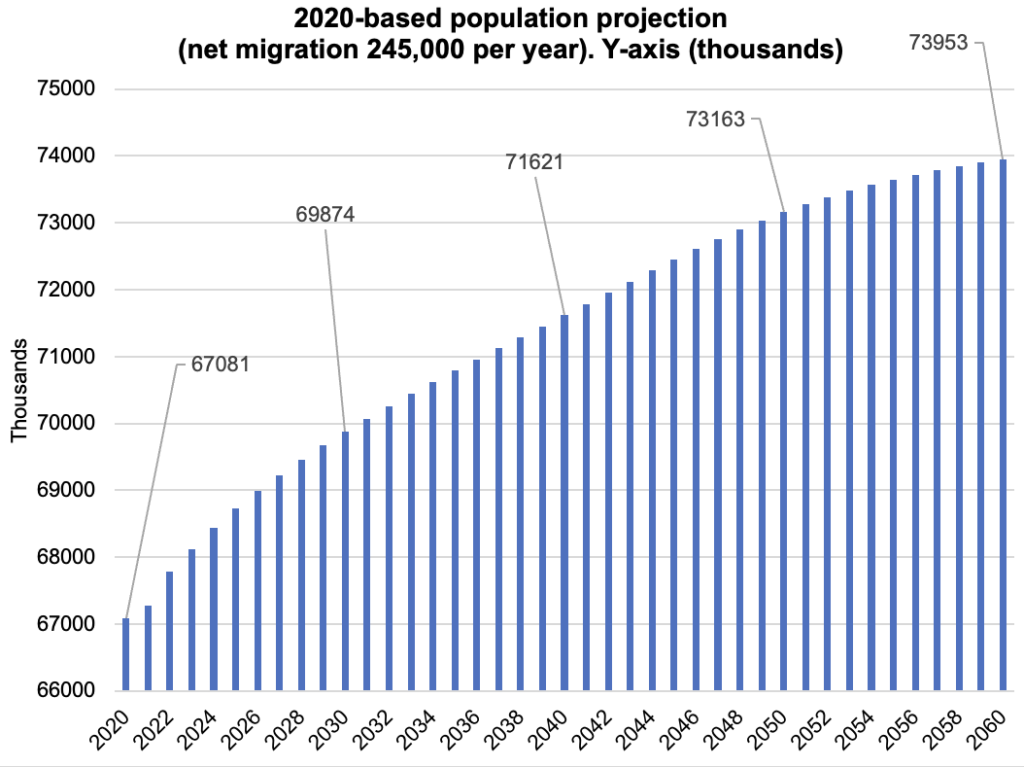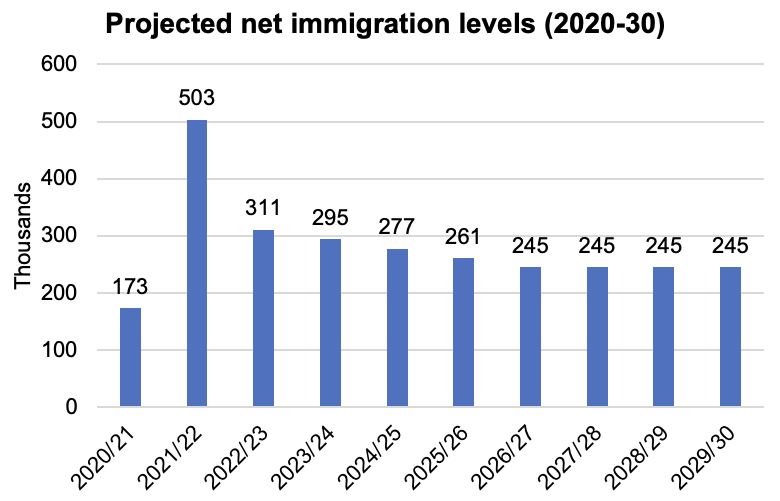
The Office for National Statistics (ONS) has released a new population projection for the UK which estimates that the number of people living here will rise from 67 million in 2020 to 74 million by 2060 – a rise of 7 million people over 40 years – see graph below.
This translates averaging out over the period to a population rise of at about 172,000 per year (a significant fall from the 300,000 to 500,000 annual rises that we have experienced in recent years).
These statistics are widely used in planning, for example, fiscal projections, health, education and pensions.
Figure 1: ONS 2020-based interim national population projections: year ending June 2022 estimated international migration variant. See source.

Although a rise of seven million people by 2060 seems significant, it has to be compared with a UK population rise of eight million over just twenty years since 2000 (which was almost entirely due to the arrival of high numbers of immigrants and subsequent children born here in the UK).
Thus the ONS seems to be suggesting that the rate of population growth will fall considerably compared with the past two decades.
The ONS based their projection on net migration levels of just 245,000 per year from 2026/27 onwards. That has indeed been the average level of net migration since 2000.
However, this does not seem to account for the recent vast loosening of the immigration system – including a wholesale enfeebling of work and study visa controls – nor for record numbers of refugees migrating directly here from Ukraine, Hong Kong and Afghanistan in recent months. Our recent paper shows that a third of a million refugees directly immigrated here in the most recent year.
Indeed net migration reached more than double the ONS’s 245,000 net migration assumption in the most recent year to June 2022 (504,000) – see our comment. More than 1.2 million residence visas were granted to those from overseas in the past year (another record).
Unfortunately the ONS does not quite explain why they think immigration levels are likely to fall so dramatically from 2021/22 onwards (their predictions for immigration levels over the course of the next decade are shown below). Their past record on projecting immigration levels does not give any comfort – and they have a long history of having under-estimated likely arrival figures.
Indeed, the war in Ukraine (which has led to 190,000 people coming here in the past year) shows no sign of ending yet. Moreover, the government has committed to taking thousands more people from Afghanistan and has said they think that illegal boat arrivals will increase this year compared to the nearly 50,000 that came during 2022. Meanwhile, the Hong Kong route is still open (with more than 100,000 people having come via the route since 2021).
Figure 2: ONS estimate for net immigration levels to the UK (2020-30) – see source.

The ONS projections are very thin compared with previous years. For example the five-year projections do not appear to include estimates of future expected levels of fertility or mortality.
Nor is it clear whether the tens of thousands coming in illegal boat trips to claim asylum from safe countries in Europe are included or not. One document says not; in another they seem to be included as asylum seekers. The ONS should clarify this and explain why they think immigration will fall so dramatically.
Indeed such an expectation is at odds with one think tank which explained to the British public recently why they should get used to high levels of immigration for the foreseeable future, despite the fact that six in ten of the public want the massive level of uncontrolled immigration to be reduced.
